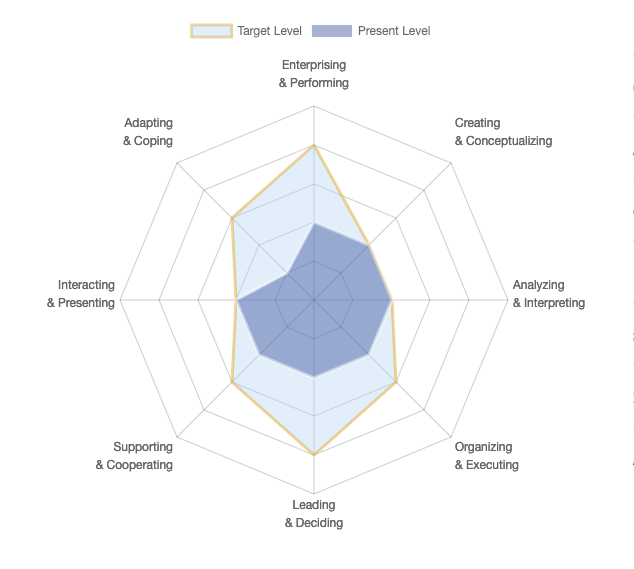Competence and Staff Development
The Role of Competency in Staff Development
Written by Sue Berry on 1st November 2017. Revised 27th January 2021.
9 min read
 This article explores effective staff development showcasing a simple but effective competency framework model that can be used by any firm of any size and complexity to explore their competence gap.
This article explores effective staff development showcasing a simple but effective competency framework model that can be used by any firm of any size and complexity to explore their competence gap.
To understand competence gap you need to know what competencies you have now, what you need for the future, and how you are going to develop your people to bridge the gap.
A core principle is that competence can be divided into four levels. The gap between ‘as is’ and ‘as required’ then involves progression from one level to the level above.
Defining the Competence Levels
A "trainee" is just beginning his or her learning and needs to be fully supervised. A "supervised practitioner" is able to undertake many aspects of the job, but requires their work to be checked. A "practitioner" is competent in all aspects of the role. And finally, an "expert" has extensive experience, and is fully competent and able to supervise and train others.
The Great Eight Competencies
Research has taken place over many years studying performance in the workplace. It's easy to understand that people in work have a certain level of ability, knowledge and understanding. It's also easy to understand that with an increased level of ability, knowledge and understanding comes increased competence. The higher the competence the more an individual is able to do, know and understand.
The term competence is overarching. In order to understand competence as a whole, we talk of an employee having multiple competencies. These are individually identifiable and therefore individually assessed and developed.
 When a manager assesses an employee's performance they do so based on competencies - much of the time without realising it! How many times have you heard “I told him what to do, but he didn’t listen”? Understanding competencies allows us to rationalise this. The ability to listen is a competency. Maybe the individual wasn’t able to analyse and interpret what they were being told. By increasing our understanding about competencies we become better able as managers to understand current and required competencies.
When a manager assesses an employee's performance they do so based on competencies - much of the time without realising it! How many times have you heard “I told him what to do, but he didn’t listen”? Understanding competencies allows us to rationalise this. The ability to listen is a competency. Maybe the individual wasn’t able to analyse and interpret what they were being told. By increasing our understanding about competencies we become better able as managers to understand current and required competencies.
Researchers have shown that there are eight high-level competencies made up of 112 component competencies[1]. These general competencies are known as the Great Eight. Every competency held by every person can be generalised back to the Great Eight. Using the Great Eight it is possible to determine what level of competence is required for satisfactory performance in any particular role. The eight competencies are shown below along with a description of each.
| Great Eight | Description |
|---|---|
| Creating and Conceptualising | The role holder works well in situations requiring openness to new ideas and experiences. This includes learning opportunities. They handle situations and problems with innovation and creativity. They think broadly and strategically. They support and drive organisational change. |
| Analysing and Interpreting | The role holder shows evidence of clear analytical thinking. They get to the heart of complex problems and issues. They apply their own expertise effectively. They are quick to take on new technology. They are able to communicate well using the written word. |
| Organising and Executing | The role holder plans ahead and works in a systematic and organised way. They follow directions and procedures. They focus on customer satisfaction and deliver a quality service or product to an agreed standard. |
| Adapting and Coping | The role holder adapts and respond well to change. They manage pressure effectively and cope well with setbacks. |
| Interacting and Presenting | The role holder communicates and networks effectively. They are able to successfully persuade and influence others. They relate to others and are confident, exhibiting a relaxed manner. |
| Supporting and Cooperating | The role holder supports others and shows respect and positive regard for others in social situations. They put other people first, working effectively with individuals and teams, clients and staff. They behave consistently with clear personal values that complement those of the organisation. |
| Leading and Deciding | The role holder takes control and exercises leadership. They initiate action, give direction and take responsibility. |
| Enterprising and Performing | The role holder focuses on results and on achieving personal work objectives. They work best when work relates closely to the results and where the impact of personal effort is obvious. They focus on results and achieve personal work objectives. They show an understanding of business, commerce, and finance. They seek opportunities for self-development and career advancement. |
The Firm's Competence
Each of the Great Eight can be held at one of the four levels – Trainee, Supervised Practitioner, Practitioner or Expert. Most people hold a mix of levels – we can’t all be expert at everything!
The total competence held in a company is an aggregation of all competencies and levels. A unit of competency is, for example, one person holding Enterprising and performing at the Supervised Practitioner level in that competency.
By understanding how many ‘units’ of each competency a business has compared with the ‘units’ needed, it’s possible to determine the gap and therefore the development needed.
Using the framework
When an individual is appointed to a role, demands are placed on them to achieve certain outcomes. The outcomes require the role holder to hold a defined set of competencies.
Let’s consider a real work scenario in order to see how the required competencies map to the Great Eight. In our example, the desired outcome is to successfully and safely navigate a ship up Southampton Water. So, we’d likely need to be able to read charts (Analysing and Interpreting). We need to understand how the forces of tides act on a given type of ship (Adapting and Coping). We’d also need to know the ‘rules of the road’ and what the various buoys and navigation marks mean while we make the voyage (Organising and Executing). That’s (at least) three competencies required for a single outcome.
Role holders will demonstrate a competency to one of the four given levels, as discussed earlier. A trainee will perhaps determine the effects of the tide on their vessel, but a practitioner or an expert will check their work.
Roles and Outcomes
Every role includes a set of desired outcomes. These are defined in the Principal Accountabilities section of the Job Description. In our sailing example above we see that each outcome needs a number of competencies.
Employees usually only need competencies in the technical aspects of their work. Managers, however, typically need technical competencies (to know what their teams are doing) and also managerial competencies (to be able to cause their teams to do what’s needed).
Manager competence
Managers, when promoted from employees, typically have the technical competencies but rarely learn managerial competencies. Government statistics show that less than 20% of all managers are trained to manage people and finance and arguably therefore, unless managers have taken other action to learn, less than 20% have the necessary competencies for the demands of their job.
Since imbalance between job demands and job resources causes stress, and since stress is a cause of burnout, this is a worrying statistic for UK plc.
Imbalance in job demands and job resources can only mean one of three things. The job is done with inadequate safety, quality, speed or effectiveness; or stress rises in the jobholder, resulting in sickness or burnout; or the jobholder quits.
It is therefore important for both managers and employees to determine the competencies needed to excel in the job they’ve chosen to do. And it’s for each to take whatever action necessary to develop their competencies.
Defining and closing the competence gap
The discussion above showed that competencies exist at different levels. And it showed that the company might need those or other competencies to exist at higher levels.
Closing the gap requires two activities. The first is to objectively measure the gap between existing competencies and those needed. The second is to put in place the learning needed to effect the move from the current levels to new required levels.
The personal benefits of success through competence are many. Successful outcomes build confidence. Confidence and competence join to produce even greater performance and achieved outcomes. Competence is therefore central to employee and manager success and progress.
Competencies add to the technology an employee uses. With behaviour, the three give the firm a capability. That capability describes the firm’s competitive advantage.
The firm’s benefit of increased competence is increased competitive advantage and ultimately increased profits and stakeholder benefit.
And the dis-benefits of poor competence are all too obvious.
Measuring the gap

A mini version of our grow your people tool can be used on our tools website allowing you to assess one role. Simply follow the instructions and think about your chosen role in terms of the Great Eight general set of competencies. You can then log your current level of each competency and describe your future requirements. By adding notes you can specify what actions you will take to move from the current level to the required level. This mini tool uses the Great Eight; the full competency framework tool that we would use when working with clients allows a set of specific competencies to be described assessing all the competencies relevant to the role within the firm.
Train, recruit or buy
Once the competence gap has been determined, the firm has a choice when it comes to acquiring the competencies needed by its managers and staff. The choice is called the ‘make or buy decision’. In essence the firm can train and develop its managers and staff or it can buy in the required competencies from consultants, contractors or new recruits.
Whether a firm makes or buys depends on which of the competencies it regards as essential in its staff and managerial body and which it sees as able to be bought in when needed. Sensible use of external competencies is beneficial. After all, many skippers employ specialist pilots to take their ship up in to Southampton. Few can be expert in navigating every port in the World.
Fundamental competence
Having the right competence is fundamental to a firm’s success.
As discussed, the individual competencies and levels applying to employees, managers and to the business as a whole can be assessed. Competencies as ability, knowledge and understanding determine performance.
Lack of these characteristics means under-performance and problems for management. Identification of the competence gap, and the acquisition and management of competence is key to organisational fitness and survival.
- Bartram, D (2005) The Great Eight Competencies: A Criterion-Centric Approach to Validation, The Journal of Applied Psychology, Vol. 90 (No. 6), 1185–1203